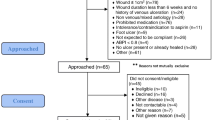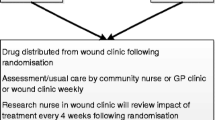Abstract
Background
Chronic venous leg ulcers (CVU) are a common, unresolved medical problem. Silica gel fibre (SGF) is a novel biodegradable inorganic material developed to serve as a carrier substrate for the local release of pharmaceutical agents facilitating tissue repair.
Objectives
To assess the performance and safety of SGF in subjects with CVU.
Methods
Open, randomized, standard-of-care-controlled, multi-centre trial. Subjects (ITT 120 patients) received either SGF in addition to standard treatment or standard-of-care treatment (S-o-C) alone. The primary performance variable was the time to healing of the target ulcer until the end of a 12 week treatment period.
Results
SGF was well tolerated. Mean time to healing up to week 12 was 85.62 days for the SGF group (SE ± 1.5) and 79.66 days for the S-o-C group (SE ± 1.77) (p-value = 0.217). There was no statistically relevant difference regarding the incidence of complete healing of the target ulcers by weeks 12 and 24 between the SGF and the S-o-C groups (p-value >0.05).
Conclusion
SGF is well tolerated and offers a promising perspective as a carrier substrate for the local release of active pharmaceutical agents into the wound site to promote tissue repair.
Similar content being viewed by others
Change history
16 August 2014
An Erratum to this paper has been published: https://doi.org/10.1684/ejd.2014.2395
References
Meyer V, Kerk N, Meyer S, George T. Differential diagnosis and therapy of leg ulcers. J Dtsch Dermatol Ges 2011; 9: 1035–1053.
Rabe E, Pannier-Fischer F, Bromen K, Schuldt K, Stang A, Poncar Ch A. Bonn Vein Study by the German Society of Phlebology. Phlebologie 2003; 32: 1–14.
Diener H, Herberger K, Augustin M, Debus ES. Chronical wound management. Phlebologie 2011; 40: 303–316.
Chaby G, Senet P, Vaneau M, et al. Dressings for acute and chronic wounds: a systematic review. Arch Dermatol 2007; 143: 1297–1304.
Metcalfe AD, Ferguson MWJ. Tissue engineering of replacement skin: the crossroads of biomaterials, wound healing, embryonic development, stem cells and regeneration. J R Soc Interface 2007; 4: 413–437.
Lutolf MP, Hubbell JA. Synthetic biomaterials as instructive extracellular microenvironments for morphogenesis in tissue engineering. Nat Biotechnol 2005; 23: 47–55.
Martino MM, Tortelli F, Mochizuki M. Engineering the growth factor microenvironment with fibronectin domains to promote wound and bone tissue healing. Sci Transl Med 2011; 3: 100ra89.
Grotheer V, Goergens M, Fuchs PC, et al. The performance of an orthosilicic acid-releasing silica gel fibre fleece in wound healing. Biomaterials 2013; 34: 7314–7327.
Ince P, Game FL, Jeffcoate WL. Rate of healing of neuropathic ulcers of the foot in diabetes and its relationship to ulcer duration and ulcer area. Diabetes Care 2007; 30: 660–663.
Moffatt CJ, Doherty DC, Smithdale R, Franks PJ. Clinical predictors of leg ulcer healing. Br J Dermatol 2010; 162: 51–58.
Gelfand JM, Hoffstad O, Margolis DJ. Surrogate endpoints for the treatment of venous leg ulcers. J Invest Dermatol 2002; 119: 1420–1425.
Palfreyman SJ, Nelson EA, Lochiel R, Michaels JA. Dressings for healing venous leg ulcers. Cochrane Database Syst Rev 2006: CD001103.
O’Donnell TF Jr., Lau J. A systematic review of randomized controlled trials of wound dressings for chronic venous ulcer. J Vasc Surg 2006; 44: 1118–1125.
Steed DL, Donohoe D, Webster MW, Lindsley L. Effect of extensive debridement and treatment on the healing of diabetic foot ulcers. Diabetic Ulcer Study group. J Am Coll Surg. 1996; 183: 61–64.
Doerler M, Reich-Schupke S, Altmeyer P, Stücker M. Impact on wound healing and efficacy of various leg ulcer debridement techniques. J Dtsch Dermatol Ges 2012; 10: 624–632.
Margolis DJ, Berlin JA, Strom BL. Risk factors associated with the failure of a venous leg ulcer to heal. Arch Dermatol 1999; 135: 920–926.
Wong IKY, Andriessen A, Charles HE, et al. Randomized controlled trial comparing treatment outcome of two compression bandaging systems and standard care without compression in patients with venous leg ulcers. J Eur Acad Dermatol Venereol 2012; 26: 102–110.
Author information
Authors and Affiliations
Corresponding author
Additional information
Registration number and name of trial registry: Study number SGF271-01, ClinicalTrials.gov identifier: NCT00998673. Study title “Randomized standard-of-care-controlled trial of a SGF wound dressing in the treatment of chronic venous leg ulcers”. Information of trial protocol: http://clinicaltrials.gov/ct2/show/NCT00998673.
About this article
Cite this article
Brown, A., Augustin, M., Jünger, M. et al. Randomized standard-of-care-controlled trial of a silica gel fibre matrix in the treatment of chronic venous leg ulcers. Eur J Dermatol 24, 210–216 (2014). https://doi.org/10.1684/ejd.2014.2344
Received:
Published:
Issue Date:
DOI: https://doi.org/10.1684/ejd.2014.2344




